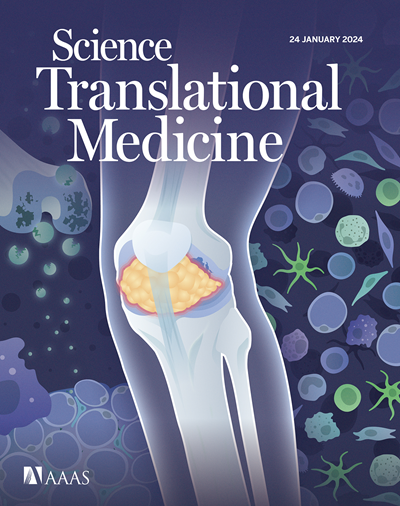一种RNA结合和细胞穿透抗体的系统管理针对多种癌症小鼠模型的治疗RNA
IF 14.6
1区 医学
Q1 CELL BIOLOGY
引用次数: 0
摘要
人们对rna作为合理设计的治疗剂的发展有着浓厚的兴趣,特别是在肿瘤学领域,其中主要的焦点是使用rna刺激模式识别受体来利用先天免疫反应。然而,静脉给药后无法在靶细胞内选择性递送治疗性rna阻碍了这种治疗癌症和其他疾病的发展。在这里,我们发现一种肿瘤靶向、细胞穿透和RNA结合的单克隆抗体TMAB3可以形成稳定的、离散大小的非共价抗体/RNA复合物,介导RNA进入肿瘤的高度特异性和功能性递送。利用模式识别受体视黄酸诱导基因i (RIG-I)的激动剂3p-hpRNA,我们在小鼠胰腺癌、成神经管细胞瘤和黑色素瘤模型中观察到系统给药TMAB3/3p-hpRNA复合物的强大抗肿瘤效果。在免疫功能正常的小鼠KPC同基因原位胰腺癌模型中,TMAB3/3p-hpRNA治疗使动物存活率增加了两倍,肿瘤生长降低,并特异性靶向恶性细胞,肿瘤肿块内RNA递送到肿瘤细胞中的差异为非恶性细胞的1500倍。单细胞RNA测序(scRNA-seq)和流式细胞术显示,TMAB3/3p-hpRNA处理引发了有效的抗肿瘤免疫反应,其特征是rig - 1激活,细胞毒性T细胞的浸润和活性增加。这些研究证实,TMAB3/RNA复合物可以特异性地将RNA有效载荷传递到难以治疗的肿瘤细胞中,从而达到抗肿瘤的效果,为推进RNA治疗癌症患者的研究提供了一个基于抗体的平台。本文章由计算机程序翻译,如有差异,请以英文原文为准。
Systemic administration of an RNA binding and cell-penetrating antibody targets therapeutic RNA to multiple mouse models of cancer
There is intense interest in the advancement of RNAs as rationally designed therapeutic agents, especially in oncology, where a major focus is to use RNAs to stimulate pattern recognition receptors to leverage innate immune responses. However, the inability to selectively deliver therapeutic RNAs within target cells after intravenous administration now hinders the development of this type of treatment for cancer and other disorders. Here, we found that a tumor-targeting, cell-penetrating, and RNA binding monoclonal antibody, TMAB3, can form stable, noncovalent antibody/RNA complexes of a discrete size that mediate highly specific and functional delivery of RNAs into tumors. Using 3p-hpRNA, an agonist of the pattern recognition receptor retinoic acid–inducible gene-I (RIG-I), we observed robust antitumor efficacy of systemically administered TMAB3/3p-hpRNA complexes in mouse models of pancreatic cancer, medulloblastoma, and melanoma. In the KPC syngeneic, orthotopic pancreatic cancer model in immunocompetent mice, treatment with TMAB3/3p-hpRNA tripled animal survival, decreased tumor growth, and specifically targeted malignant cells, with a 1500-fold difference in RNA delivery into tumor cells versus nonmalignant cells within the tumor mass. Single-cell RNA sequencing (scRNA-seq) and flow cytometry demonstrated that TMAB3/3p-hpRNA treatment elicited a potent antitumoral immune response characterized by RIG-I activation and increased infiltration and activity of cytotoxic T cells. These studies established that TMAB3/RNA complexes can deliver RNA payloads specifically to hard-to-treat tumor cells to achieve antitumor efficacy, providing an antibody-based platform to advance the study of RNA therapies for the treatment of patients with cancer.
求助全文
通过发布文献求助,成功后即可免费获取论文全文。
去求助
来源期刊

Science Translational Medicine
CELL BIOLOGY-MEDICINE, RESEARCH & EXPERIMENTAL
CiteScore
26.70
自引率
1.20%
发文量
309
审稿时长
1.7 months
期刊介绍:
Science Translational Medicine is an online journal that focuses on publishing research at the intersection of science, engineering, and medicine. The goal of the journal is to promote human health by providing a platform for researchers from various disciplines to communicate their latest advancements in biomedical, translational, and clinical research.
The journal aims to address the slow translation of scientific knowledge into effective treatments and health measures. It publishes articles that fill the knowledge gaps between preclinical research and medical applications, with a focus on accelerating the translation of knowledge into new ways of preventing, diagnosing, and treating human diseases.
The scope of Science Translational Medicine includes various areas such as cardiovascular disease, immunology/vaccines, metabolism/diabetes/obesity, neuroscience/neurology/psychiatry, cancer, infectious diseases, policy, behavior, bioengineering, chemical genomics/drug discovery, imaging, applied physical sciences, medical nanotechnology, drug delivery, biomarkers, gene therapy/regenerative medicine, toxicology and pharmacokinetics, data mining, cell culture, animal and human studies, medical informatics, and other interdisciplinary approaches to medicine.
The target audience of the journal includes researchers and management in academia, government, and the biotechnology and pharmaceutical industries. It is also relevant to physician scientists, regulators, policy makers, investors, business developers, and funding agencies.
 求助内容:
求助内容: 应助结果提醒方式:
应助结果提醒方式:


